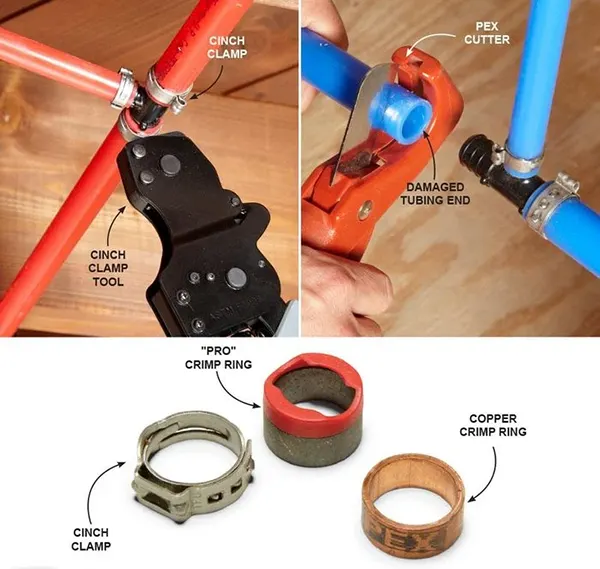Doing it yourself at home can be the best way to get your plumbing work done. And whenever it comes to DIY-ing your plumbing work, PEX pipes are your greatest companion. Since their launch, these pipes have managed to make a strong presence in the market.
With a collection of perfect tools and some efficient skills, these pipes are the best suited for domestic use. Easy to cut and install, they are all you need for your supply needs.
And for the very same reason, this write-up is going to take you on a ride to becoming a pro at plumbing with PEX pipes.
Understanding PEX Pipes
Prior to understanding how it works, it is necessary to get familiar with it:
What are PEX Pipes?
PEX is nothing but a cross-linked polyethylene material, specially crafted to be durable, flexible, and affordable at the same time. Along with that, they are built to handle high-temperature, chemical resistance, and environmental stress crack resistance (ESCR).
Benefits of Using PEX Pipes
Following are some benefits that you won’t be able to enjoy in regular pipes:
- Flexibility: Easy to bend across the corners or to fit in tight places.
- Durability: More resistant to chemical reactions and heat.
- Easy to Install: The installation process is super easy. With just a few tools, the process is too simple to install.
Types of PEX Pipes
You get three different options from which you can pick the right one for you:
- PEX-A: Super flexible, no nicks or kinks, perfect fit for tight places.
- PEX-B: Extremely strong and durable, less flexible than PEX-A.
- PEX-C: Suitable for cold temperatures, stiffer than PEX-A & B.
Essential Tools and Materials

To install these pipes, you would need some extra supplies. The following are those listed:
Tools You’ll Need
Go to the hardware store and get your hands on these items:
- PEX Cutter: To cut your pipe with perfection.
- Crimping Tool: Tightly secure pipes with copper fittings
- Go/No-Go Gauge: Reassure proper fittings.
- Pipe Extender: Elongate pipes according to the need (only PEX-A).
Materials Required
Following are some materials that will come in handy:
- PEX Pipes
- Fittings
- Copper crimp rings or stainless steel clamps
- Manifold
Safety Gears
Your safety is also necessary. Gather the following resources:
- Gloves
- Safety Glasses
Planning Your Installation
Planning properly can provide you with a clear image of how the process needs to be done:
Mapping Out the Plumbing System
Going for building a plan where you figure out all the critical points and locations for fixtures is necessary. It can give you an image of how much material is needed and how the execution must be done.
Calculating Pipe Lengths
Since you have created the master plan, you will now be able to find out the measurements or lengths of pipes and other materials required for the plumbing task.
Selecting the Right Fittings
Since you have the idea of both measurement and a proper execution plan, you must be aware of how and what fittings would suit the best for your task.
Preparing for Installation
Now that you have planned the whole process in your mind, it’s now time to prepare and gather all the stuff:
Cutting the PEX Pipes
It’s now time to get help from the PEX cutter you purchased from the hardware store. Make clean and clear cuts with the help of a PEX cutter with proper measurements.
Expand the Pipe Ends (PEX-A Only)
If any pipe is short, or if you have cut down wrong measurements by mistake, you can extend them with a pipe extender. You can do so with PEX-A pipe only.
Crimping the Connections
Finally, the copper crimping ring allows you to fit the pipe’s end to the fitting. Now, squeeze and fasten until the tool releases. Lastly, use a Go/No-Go gauge to ensure a strong joint.
Installing the Manifold
Manifold is a key tool in plumbing allowing the segregation of hot and cold water. Here’s how to install them:
Benefits of Using a Manifold
Manifold is the central component of the whole water pipe network that allows you to control the flow from different channels with ease.
Setting Up the Manifold
Find a suitable location where the manifold is easily installed and accessible. Connect all the water supply pipes with the inlet and outlet of the manifold.
Connecting PEX Pipes With the Manifold
The final step includes making all the connections required for the proper flow. You can mark those pipes accordingly to ease their identification.
Testing Your Installation
There is a high chance of failure if you are going DIY. Therefore, consider the following tips:
Checking for Leaks
Use watertight seals and appropriate materials on all the joints and fittings to avoid any chance of possible water leaks.
Flushing the System
During installation, debris, and unwanted elements can damage the entire channel of the network. Thus, flush the system with running water to get that debris out.
Final Inspection
Run a final walkthrough on the complete network of the connection. Focus on any knicks or kinks that may cause issues in the future.
Troubleshooting Common Issues
If you are having any problems after the installation, the following tips may help you:
Leaking Connections
In case there is any leakage in the system, checking the crimp rings or clamps can be of great help. Apart from that, if there is any issue, re-crimp or tighten the bond again.
Kinks in the Pipes
The best possible solution if there is a kink is to heat the area gently with a heat gun and reheat the pipe.
Inconsistent Water Pressure
The most common issue is the low or inconsistent water pressure. For that, check if there is a partially closed or clogged valve. If there is, try to remove the debris or ensure the proper working of fixtures.
Maintaining Your PEX System
Now the concern is how to maintain the whole system properly throughout its life. For that, follow the given maintenance tips:
Regular Inspections
Timely ensure and inspect the whole network of pipes and fixtures. Also, keep track of proper time intervals.
Winterizing Your System
If you live in a cold location where winters are harsh, low temperatures can damage your pipes. To avoid such a situation, winterize the whole system with insulation and drain outdoor lines.
Professional Maintenance
In case the problem is major, and you are unable to solve it, contact a professional plumber in Layton to seek help.
Final Words
PEX pipes are one of the best options currently available in the market. There are 3 types of pipes divided into A, B, and C categories that are used under different circumstances. If you find the article helpful, share it with others who are in need.
Also Read: The Hidden Importance of Regular Water System Pumping




